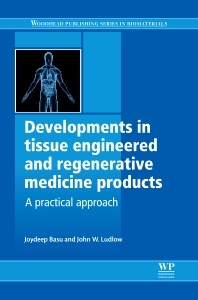Description
Developments in Tissue Engineered and Regenerative Medicine Products
A Practical Approach
Woodhead Publishing Series in Biomaterials Series
Authors: Basu Joydeep, Ludlow John W
Language: English
Subject for Developments in Tissue Engineered and Regenerative...:
226 p. · 15.5x23.3 cm · Hardback
Description
/li>Contents
/li>Biography
/li>Comment
/li>
List of figures, tables and boxes
About the authors
Woodhead Publishing Series in Biomaterials
Preface
Acknowledgements
Chapter 1: Overview of tissue engineering/regenerative medicine
1.1 Introduction
1.2 Cells
1.3 Biomaterials
1.4 Therapeutic product delivery
Chapter 2: Cells
Abstract
2.1 Introduction
2.2 Mechanism of action of cell-based therapeutics
2.3 Other stem cell-based therapeutics currently under development
2.4 Development of genome modification technologies: gene-based cell therapies
2.5 Committed cell types: ideal candidates for TE/RM product development
2.6 Summary: key features favoring commercial development of cellular ABIs
Chapter 3: Biomaterials for TE/RM products
Abstract
3.1 Introduction
3.2 The ECM: comparator for biomaterials
3.3 Decell/recell: the ultimate biomaterial platform?
3.4 Selection of biomaterials for tissue engineering: illustrative example – kidney
3.5 Biomaterials candidates for renal tissue engineering
3.6 Selection of biomaterials for tubular organs: bladder, esophagus and small intestine
Chapter 4: Neo-Bladder: a foundational technology platform for tubular organ regeneration
Abstract
4.1 The need for urinary neo-organs
4.2 TE/RM methodologies for bladder replacement and augmentation
4.3 Demonstration of Neo-Bladder formation in large animals
4.4 Can neo-bladder constructs be made from cells sourced from diseased patients?
4.5 Neo-bladder replacement in human pediatric patients – first clinical trials of a neo-organ
4.6 Making the product: cell sourcing
4.7 Definition of the cell source used for seeding neo-bladders: adipose
4.8 Other approaches to tissue engineering neo-bladders
4.9 Key results from development of the Neo-Bladder: factors facilitating commercial viability of an organ regeneration platform
Chapter 5: Neo-Urinary Conduitâ„¢
Abstract
5.1 Introduction
5.2 Assembly of the NUC
5.3 Preclinical evaluation of the NUC
5.4 Assembly of an NUC cell/scaffold composite
5.5 GLP preclinical analysis of de novo NUC formation in a porcine cystectomy model
5.6 Alternate cell sourcing of SMC for seeding of the NUC
5.7 Clinical trials of the NUC
5.8 Regeneration of muco-cutaneous region at the skin/conduit junction
5.9 Speculations for the future
Chapter 6: Tissue engineering of non-bladder tubular organs
Abstract
6.1 Introduction
6.2 Vasculature
6.3 Lung
6.4 Gastrointestinal tract
6.5 Genito-urinary system
Chapter 7: Tissue engineering of solid organs
Abstract
7.1 Introduction
7.2 Kidney
7.3 Heart
7.4 Liver
7.5 Pancreas
7.6 Spleen
7.7 Central nervous system
7.8 Summary
Chapter 8: Regulatory and quality control
Abstract
8.1 Good manufacturing practice
8.2 Good tissue practices
8.3 GMP-compliant laboratories and manufacturing facilities
8.4 Standard operating procedures and batch records
8.5 Personnel training and documentation
8.6 Best practices and the need for harmonization
8.7 Investigational New Drug application
Chapter 9: Pre-clinical and clinical evaluation of TE/RM products
Abstract
9.1 Regulation of TE/RM products
9.2 Preclinical studies
9.3 Clinical protocol development
9.4 Clinical trial
9.5 Clinical trial site monitoring
9.6 Contract research organization
Chapter 10: Manufacturing
Abstract
10.1 Facility considerations
10.2 Clean rooms
10.3 Environmental monitoring
10.4 Process controls
10.5 Raw material qualification
10.6 Manufacturing process
Chapter 11: Intellectual property
Abstract
11.1 Definition of intellectual property
11.2 Landscape assessment
11.3 Operational documentation
11.4 Disclosure
11.5 Filing
11.6 Freedom to operate
11.7 Trade secrets
11.8 Trademarking
11.9 The Leahy–Smith America Invents Act
Index
Dr John W. Ludlow is Senior Director, Process Research and Assay Development, Tengion Inc., in Winston-Salem, North Carolina, USA. With experiences as Director of the Cell Therapy Program at Incara Pharmaceuticals, and Senior Director of the Cell Therapy Program at Vesta Therapeutics (North Carolina, USA), he has achieved demonstrable successes in managing and directing therapeutic area-specific research and regenerative medicine and tissue engineering product development. Responsibilities have included bringing new products into bioprocessing research and development, taking new products to demonstration in animal models, GLP and non-GLP production, and initiation of human clinical trial sites. Dr. Ludlow has previous held faculty memberships at the Rochester Institute of Technology and the University of Rochester Cancer Center, with authorship on over 80 scientific publications.
- Addresses practical considerations for the field of tissue engineering and regenerative medicine from the perspective of the biotechnology industry
- Written as a manual for tissue engineering and regenerative medicine product development applicable to the US and EU
- Illustrates pathway integration of science and business required for successful product development




